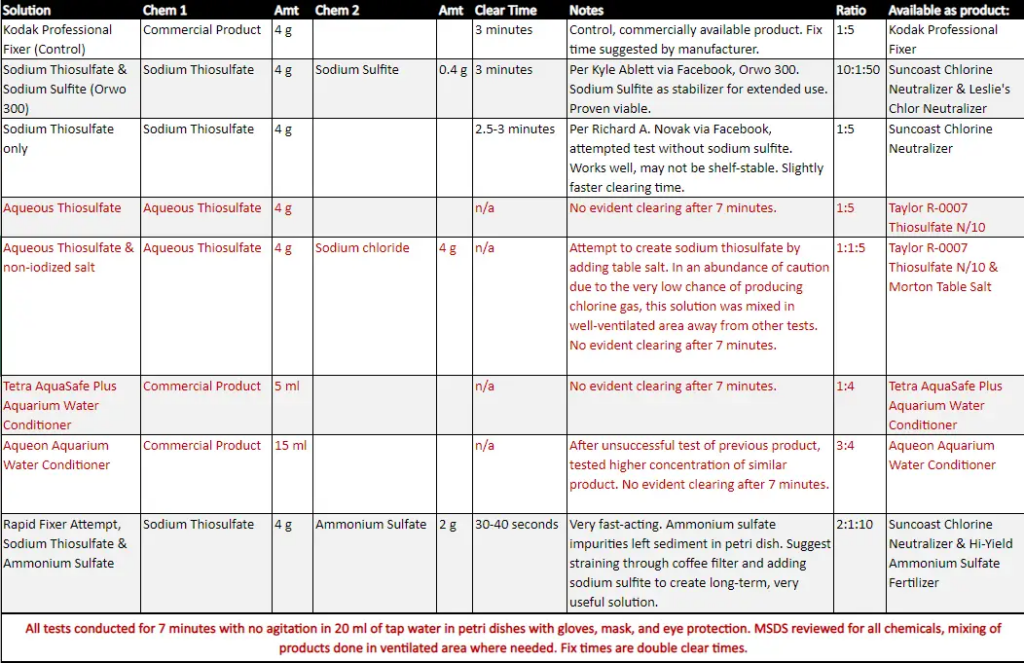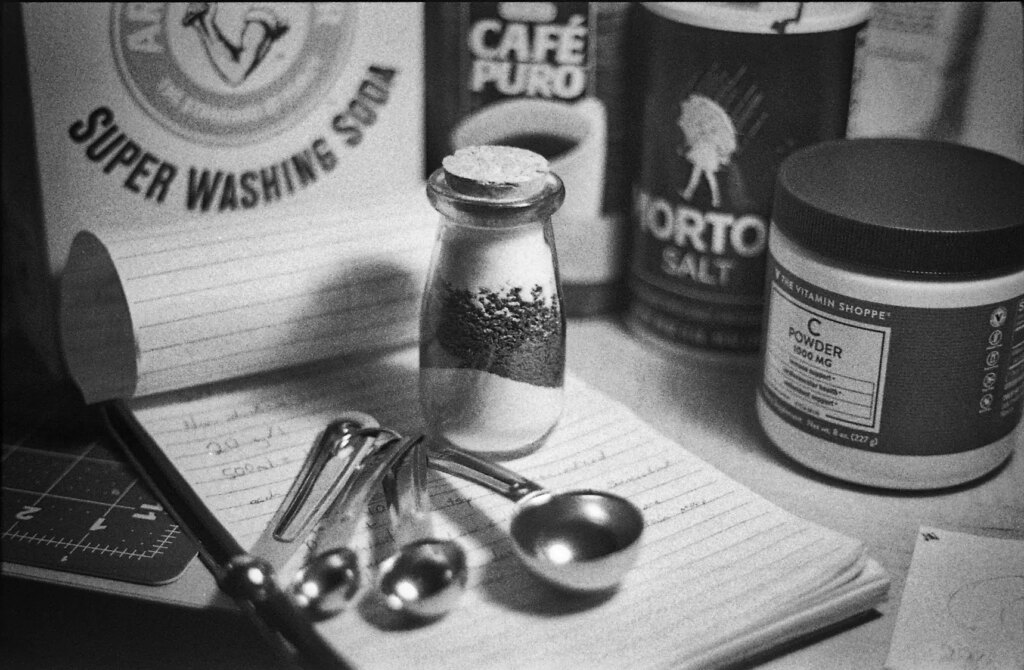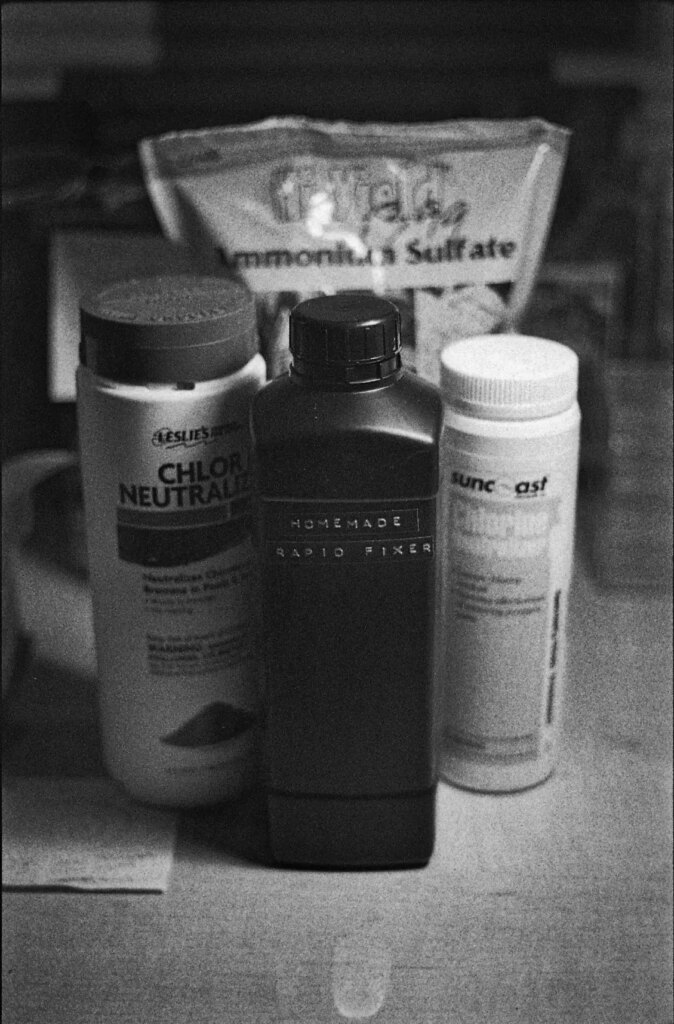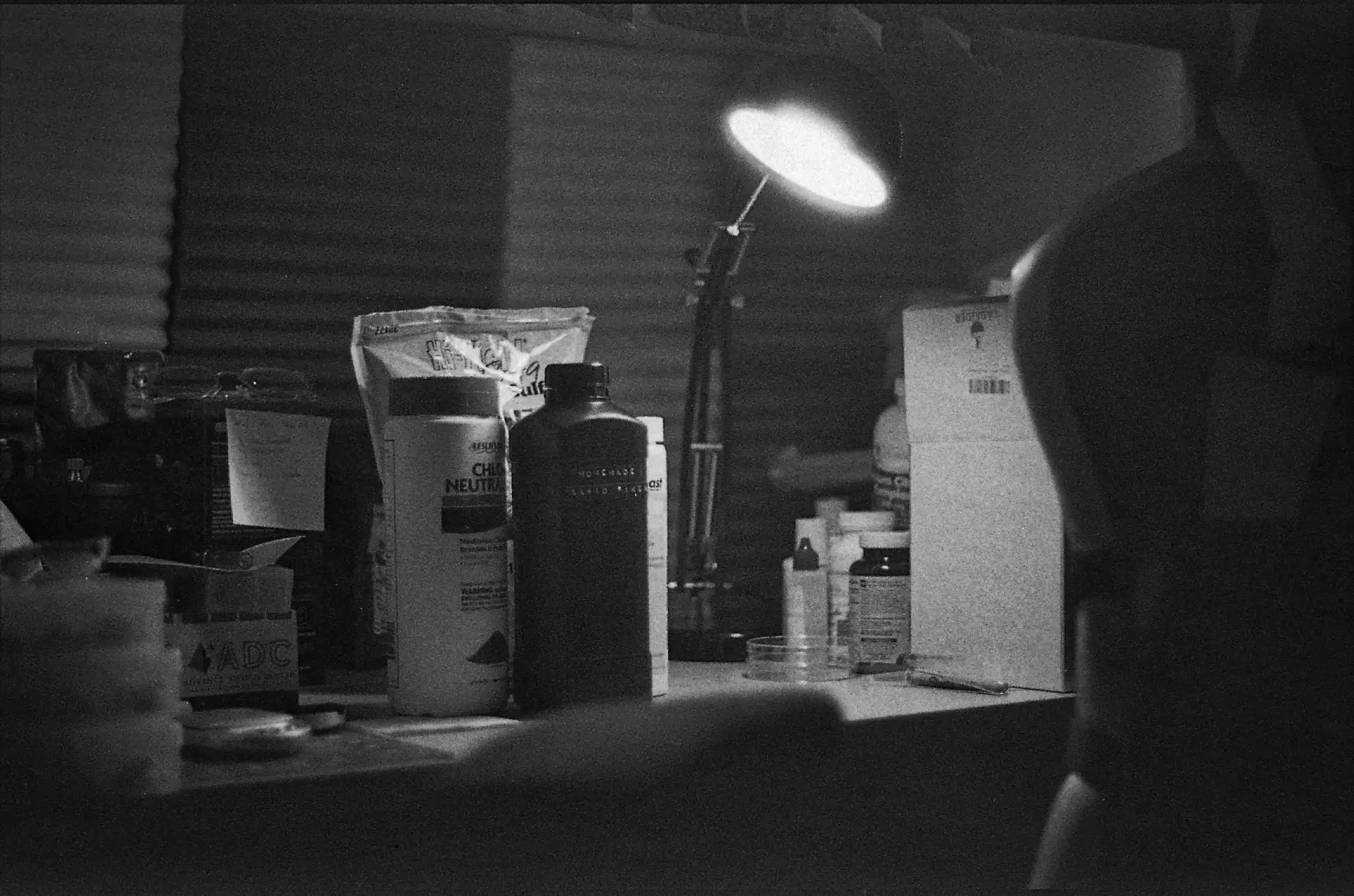Fixer is both cheap and abundant, which is great for those of us that enjoy developing our own negatives. However, in the search for local alternatives for film development, it presented a problem. Because it’s so easy to acquire, few have bothered to try making it themselves.
This is not to say that no one has; in fact, there is an active community of folks that buy and mix their own chemicals and achieve a high degree of nuanced control over their results. But ordinarily, they buy from reputable photography suppliers and not from the supermarket.
My experimentation with reversal processing and developing had opened my eyes to the possibility of the individual chemical components of developing chemistry being available from unintuitive sources. Potassium Bromide, a common development restrainer, could be found in anticonvulsant medication for dogs. All I had to do was find out what the chemicals were, and I could start searching for alternatives.
My posts within the Vintage Camera Users Facebook group had happily stimulated some insightful conversations about developing methods. In particular, I was given a basic formula for Orwo 300 developer by photographer Kyle Ablett, which calls for only 2 ingredients: sodium thiosulfate and sodium sulfite. Photographer Richard A. Novak added that the sodium sulfite typically acts as a stabilizer for reusable fixers, and that it could be omitted for a one-shot fixer. Moreover, photographer Daniel Keating explained that you could add ammonium sulfate to the mixture and create a rapid fixer.
I brainstormed with the group on different ways one could source the materials locally. If your supermarket has pool dechlorinator made of pure sodium thiosulfate, you already have everything you need to make a fixer (and it’s also available in pool supply shops and even pet stores). But there were many options. Ammonium sulfate is used as a fertilizer and can be found at nurseries and some hardware stores. Sodium sulfite can be found at pool supply shops (also as dechlorinator), at sporting goods stores (as bait or fish egg cure), and at home-brewing shops (as a fermentation stopper).
The list was surprisingly long, and the ways to combine them were various. This was a very exciting prospect, as I could test different combinations, and different available products, to see what could be viable for this project.
At the end of the day, I returned home with:
- Sodium Thiosulfate
- Suncoast Chlorine Neutralizer
- Tetra AquaSafe Plus Aquarium Water Conditioner
- Aqueon Aquarium Water Conditioner
- Sodium Sulfite
- Leslie’s Chlor Neutralizer
- Aqueous Thiosulfate
- Taylor R-0007 Thiosulfate N/10
- Ammonium Sulfate
- Hi-Yield Ammonium Sulfate Fertilizer
For the tests, I used the ratios provided for Orwo 300 to create a solution of all the products in 20ml of water, each in a corresponding petri dish. As a control, I made a fresh solution of Kodak Profession Fixer, which had been my go-to fixer for B&W photography. A small piece of film was placed in the petri dish containing the mix to be tested, all at 20 C / 68 F. I used a stopwatch to monitor clearing times, comparing to the control. I noted these times, along with the chemicals and amounts, in the following table:

Though not everything worked, I was incredibly pleased with the results. That anything worked at all, and was within miles of my house, was a thrill.
But the potential for the homemade rapid fixer was tantalizing. I had never used a rapid fixer before, and seeing the film clear in seconds was a magical experience. I had to try and make a shelf-stable (and clean) batch. I mixed more of ammonium sulfate and sodium thiosulfate, and I added sodium sulfite. After mixing, I filtered the mixture though a coffee filter with excellent results. A quick test confirmed that the clearing time was still about 30 seconds.
At that moment, I realized that I had everything I needed to develop and fix film right in front of me. I could test it. I had to test it.
I hastily snapped a few photos with my K1000 and ran to my bathroom to develop the negatives. I knew my caffenol ratio and times would work, but something about the rapid fixer had me skeptical. Something would go wrong at higher volumes, or with more film, of the fixer was incredibly short-lived. I had never fixed film for less than 7 minutes, and 1 minute felt entirely insufficient. But I had done the tests, and I trusted to my experiments.
When I pulled out the developed negatives, I laughed outloud. Using pool chemicals and fertilizer, I’d made a photographic fixer that was 83.3% faster than what I had been using up until that moment. I did a full-on Doc Brown and yelled, “It works! IT WORKS!”


Here is what I used to make the rapid fixer:
1L water
200g Sodium Thiosulfate
100g Ammonium Sulfate
20g Sodium Sulfite
Mix thoroughly and filter through a paper filter. Fix for 1 minute.
I maintain that I can go just about anywhere (in the US, anyway) and be able to pick up the ingredients to develop, fix, and even reverse process B&W films, inexpensively and quickly. And I hope that, someday, I get a chance to say, “Hey, do you want to see something cool?” and be the coolest uncle ever.
_josh vickers
Follow me on Instagram and Facebook.
Share this post:









Comments
William Watts on Grocery Store Development – Part 3: Fixing Film with Pool Chemicals and Fertilizer – By Josh Vickers
Comment posted: 10/06/2022
In the past, I have tried a similar approach when processing PCBs but usually found that the alternative chemicals did not work due to not being pure.
Comment posted: 10/06/2022
Steven G on Grocery Store Development – Part 3: Fixing Film with Pool Chemicals and Fertilizer – By Josh Vickers
Comment posted: 10/06/2022
Martin JONES on Grocery Store Development – Part 3: Fixing Film with Pool Chemicals and Fertilizer – By Josh Vickers
Comment posted: 10/06/2022
Comment posted: 10/06/2022
Vlad Serebryany on Grocery Store Development – Part 3: Fixing Film with Pool Chemicals and Fertilizer – By Josh Vickers
Comment posted: 13/06/2022
manelxy on Grocery Store Development – Part 3: Fixing Film with Pool Chemicals and Fertilizer – By Josh Vickers
Comment posted: 23/07/2022
150 g NaCl
500ml water
It takes a bit to get it to dissolve well. Lots of stirring and hot water are a big help.
It is not a quick fixer. You may need hours (depending on the film up to 24 hours).
https://caffenolcolor.blogspot.com/search?q=salt fixer
Comment posted: 23/07/2022
Arne Heeringa on Grocery Store Development – Part 3: Fixing Film with Pool Chemicals and Fertilizer – By Josh Vickers
Comment posted: 24/07/2022
I also develop with wine, sekt and beer. And I made Parodinal that works exactly like Rodinal.
Comment posted: 24/07/2022
Dennis O'Connor on Grocery Store Development – Part 3: Fixing Film with Pool Chemicals and Fertilizer – By Josh Vickers
Comment posted: 04/11/2022
Comment posted: 04/11/2022
Richard A. Novak on Grocery Store Development – Part 3: Fixing Film with Pool Chemicals and Fertilizer – By Josh Vickers
Comment posted: 27/01/2024
Robert Willox on Grocery Store Development – Part 3: Fixing Film with Pool Chemicals and Fertilizer – By Josh Vickers
Comment posted: 20/08/2024
Comment posted: 20/08/2024